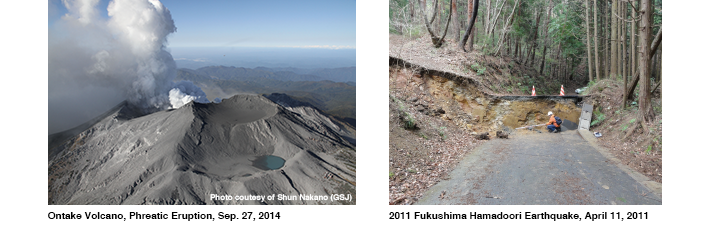


- 日付:
- 2015年3月16日(月)
- 開催の経緯:
- 2015年3月14−18日に仙台市において,第3回国連防災世界会議が開催されます.この世界会議は,今後10年間の世界における防災戦略(ポスト2015年防災枠組)を策定する重要な会議です.G-EVERコンソーシアムと産総研地質調査総合センターは,国連防災世界会議のパブリックフォーラムの1つとして,2015アジア太平洋地域地震火山ハザード・リスク情報国際シンポジウムを開催し,今後のアジア太平洋地域における地震火山のハザード・リスクに関する国際標準,共有化,評価システム等を議論することとしました.
- 開催の目的:
- アジア太平洋地域は,地震・津波・火山噴火等の大規模自然災害に対して,リスクが高い地域です.2011年の東北地方太平洋沖地震のように,一旦大規模災害が発生すれば,高度に発達した国際経済社会では,サプライチェーンへの影響など,被災国のみならず,様々な国際的な問題に発展します.大規模自然災害への対策は,人間の安全保障として,経済の持続的発展のためにも重要です.アジア太平洋地域の地震及び火山災害軽減,リスク対策は,現在各国でさまざまな活動が行われていますが,各研究機関,関連組織の協力体制の確立,防災関連情報の共有化等が必要とされています.2015アジア太平洋地域地震火山ハザード・リスク情報国際ワークショップでは,(1) 各国における地震火山災害軽減に関する現状を取りまとめ,(2) 今後の情報整備における国際標準化,ハザード・リスク評価に関する今後の発展について広く意見交換を行います.
- 日程:
- 3月16日 (月) 9:15- レジストレーション
- 3月16日 (月) 9:40-18:45 講演会及び総合討論
- 3月16日 (月) 9:40-18:45 ポスターセッション (コアタイム: 12:45-13:30, 15:35-16:15)
- 3月17日 (火) 9:00-16:45 講演会及び総合討論(招待講演者限り,岩沼屋)

- 2015アジア太平洋地域地震火山ハザード・リスク情報国際ワークショップ講演要旨集 (PDF, 4.2MB)
- 招待講演者:
- Patrick McKeever (ユネスコ自然科学部門生態地球科学部代表)
- Iskandar Zulkarnain (インドネシア科学院長官)
- Adichat Surinkum (東南アジア地球科学計画調整委員会事務局長)
- Ross Stein (グローバル地震モデル創設者, 米国地質調査所)
- Renato Solidum (フィリピン地震火山研究所所長)
- Supriyati Andreastuti (インドネシア火山地質災害防災局災害評価部部長)
- Zhongliang Wu (中国地震局地球物理研究所所長,元IASPEI会長)
- David Johnston (ニュージーランドGNSサイエンス災害研究センター所長,災害リスク統合研究科学委員会代表)
- Graham Leonard (ニュージーランドGNSサイエンス災害研究センター,国際火山学会火山と都市委員会代表)
- Nguyen Hong Phuong (ベトナム科学技術院地震及び津波警戒センター副所長)
- Cheng-Horng Lin (台湾中央研究院,Tatun火山観測所所長)
- Christina Widiwijayanti (シンガポール地球観測所)
- Marco Pagani (グローバル地震モデル地震ハザードチーム)
- Kuniyoshi Takeuchi (土木研究所水災害リスクマネジメント国際センター)
- Masato Iguchi (京都大学防災研究所桜島火山観測所所長,日本火山学会会長 )
- Ken Xiansheng Hao (防災科学技術研究所,グローバル地震モデル科学委員会副代表)
- Kentaro Imai (東北大学津波工学研究室)
- プログラム: ダウンロード (PDF, 109 KB)
- 3月16日(月)
- Welcome address:
- Chair: Yasuto Kuwahara
- 9:40-9:50 Eikichi Tsukuda (Director General, GSJ, AIST, G-EVER Consortium President)
- Session 1: International Activities for Disater Mitigation
- Chair: Yasuto Kuwahara and Naoji Koizumi
- 9:50-10:05 International Geoscience Programme and Global Geoparks: Looking Towards The Future
- Patrick McKeever (UNESCO)
- 10:05-10:15 Community-based Geo-hazard Mitigation in CCOP countries
- Adichat Surinkum (CCOP)
- 10:15-10:30 Mitigation of Earthquake and Related Hazards for Risk Reduction in Indonesia: Challenging from Research to Policy
- Iskandar Zulkarnain (LIPI), Danny Hilman Natawidjaja and Adrin Tohari
- 10:30-10:55 Building community resilience to natural hazards in Wellington, New Zealand: linking global programmes to local action
- David Johnston (JCDR, GNS Science), Emma E. H. Doyle, Bruce Pepperell, Dan Neely and Julia Becker
- 10:55-11:20 Recent volcanic and earthquake hazard and risk activities at GNS Science, New Zealand, and the Cities and Volcanoes Commission of IAVCEI
- Graham Leonard (JCDR, GNS Science)
- 11:20-11:30 [Coffee Break] (Group Photo)
- Chair: Yasuto Kuwahara and Naoji Koizumi
- 11:30-11:55 Disaster Loss Data for Risk Assessment and Achieving Post-2015 Targets for Disaster Risk Reduction
- Kuniyoshi Takeuchi (ICHARM, PWRI)
- 12:20-12:45 The OpenQuake-engine hazard component: current status and new experimental features
- Marco Pagani (GEM), Graeme Weatherill, Julio Garcia, Yen-Shin Chen, Fabrice Cotton, Ken Hao and Hiroyuki Fujiwara
- 12:45-13:30 [Lunch] & Poster Session Core Time
- Session 2: Earthquake and Volcanic Hazards and risk in Asia
- Chair: Yuzo Ishikawa and Shinji Takarada
- 13:30-13:55 G-EVER Consortium activities: towards earthquake and volcanic hazards risk mitigation in Asia-Pacific region
- Shinji Takarada (GSJ, AIST), Joel Bandibas, Yuzo Ishikawa and G-EVER Promotion Team
- 13:55-14:20 Earthquake and volcanic hazards and risk assessment efforts in the Philippines
- Renato Solidum (PHIVOLCS)
- 14:20-14:45 The important of earthquake and volcano hazard mappings in disaster risk reduction and its implementation to spetial planning
- Supriyati Andreastuti (CVGHM) and Sri Hidayati
- 14:45-15:10 Recent development of WOVOdat - The global volcano unrest database - as a resource to improve eruption forecasts
- Christina Widiwijayanti (EOS), Fidel Costa, Thin Zar Win Nang, Karine Tan, Chris Newhall, and Antonius Ratdomopurbo
- 15:10-15:35 Scientific products for the multi-scale seismic hazard and risk assessment in China: present status and future prospects
- Zhongliang Wu (CEA), and the Group for the 13th Five-Year Plan (2016~2020) for Earthquake Monitoring and Forecast of the CEA
- 15:35-16:15 Poster Session Core Time & [Coffee Break]
- Chair: Yuzo Ishikawa and Shinji Takarada
- 16:15-16:40 Seismological Evidence of Plumping System beneath the Tatun Volcano Group, Northern Taiwan
- Cheng-Horng Lin (TVO, Academia Sinica)
- 16:40-17:05 Updated Probabilistic Seismic Hazard Maps of Vietnam
- Nguyen Hong Phuong (VAST) and Pham The Truyena
- 17:05-17:30 How can the world learn the lesson from Tohoku Earthquake? : Epistemic uncertainty aspects
- Ken Xiansheng Hao (NIED) and Hiroyuki Fujiwara
- 17:30-17:55 International collaboration for mitigation of volcano hazard in Asia
- Masato Iguchi (SVRC, DPRI, Kyoto Univ.)
- Chair: David Johnston, Ross Stein and Shinji Takarada
- 17:55-18:35 General Discussion
- 18:35-18:45 Closing Remarks
- Yasuto Kuwahara (GSJ, AIST)
- Poster Session: Large-scale Earthquakes and Volcanic Eruption [Core Time: 12:45-13:30, 15:35-16:15]
- P1 The Development of Tsunami Trace Database on the Coast of Japan
- Fumihiko Imamura, Kentaro Imai (Tohoku Univ.), Yayoi Haga and Masami Sato
- P2 Try to draw the volcanic eruptions and earthquake activity in the same figure : part 1 in and around Japan
- Yuzo Ishikawa (GSJ, AIST)
- P3 Caldera forming eruptions and their characteristics of preceding activities during the last 1000 years in Sunda Arc, Indonesia
- Ryuta Furukawa (GSJ, AIST), Akira Takada and Oktory Prambada
- P4 Observation of groundwater and crustal deformation for forecasting the Tokai, Tonankai and Nankai earthquakes in Japan
- Naoji Koizumi (GSJ, AIST) and Norio Matsumoto
- P5 Variability of slips at point on fault in each of successive surface-rupturing earthquakes: examples from paleoseismology of surface ruptures in recent inland earthquakes in Japan
- Tadashi Maruyama (GSJ, AIST)
- P6 Data collection for estimation of surface deformation by faulting
- Masayuki Yoshimi (GSJ, AIST), Hidetaka Saomoto, Haruo Horikawa and Shintaro Abe
- P7 G-EVER Asia-Pacific Region Earthquake and Volcanic Hazard Information System and the CCOP Geoinformation Sharing Infrastructure for East and Southeast Asia
- Joel Bandibas (GSJ, AIST) and Shinji Takarada
- P8 Analog experiments for outreach program to understand fundamental processes of volcanic hazard
- Akira Takada (GSJ, AIST), Ryuta Furukawa, Teruki Oikawa, Seiko Yamasaki, Shinji Takarada and Shogo Komori
- P9 International activity of Geological Survey of Japan, AIST
- Toshihiro Uchida (GSJ, AIST) and Junko Hara
- (下線: 発表者)
- 3月17日(火) 9:00-16:50 [招待講演者限り]
- 場所: 岩沼屋会議室
- Current Situation and Future Strategy of the Earthquake and Volcanic Hazards and Risk in Asia-Pacific Region
- 当日参加(定員75名まで):
- 受付 3月16日(月)9時15分より 仙台市東京エレクトロンホール宮城6階602会議室
- 入場料:
- 無料
- 口頭発表及びポスター発表について:
- 口頭発表: ご発表用のPPTファイルをUSBメモリでご持参下さい.事前に,MS-Power Point 2007もしくは2012 (Windows版)での動作確認をお願いします.事務局では,講演者用の演台に,Windows用ノートパソコンを1台準備しますので,各自の発表のセッションが始まる前に,ご自身のPPTファイルをアップロードし,動作確認を行って頂ければ幸いです.動画等の関係でご自身のノートパソコンをご利用になられたい場合は,事前にご相談頂ければ幸いです.
- ポスター発表: 縦150cm x 横90cm以内でご用意下さい.掲示用のテープは事務局で準備します(ピンは使用できません).3月16日9時40分までにポスターを掲示して頂き,19時00分までには撤去をお願いします.コアタイムは,12:45-13:30と15:35-16:15の2回です(昼食時間は各自ご調整下さい).コーヒー等のドリンクサービスが行われます.
